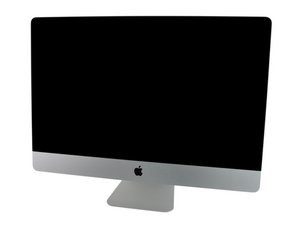Won't boot with Graphics Card inserted
I treated myself an iMac 27” i7 for Christmas.
I followed a tutorial from OWC on how to install a SSD behind the optical drive, but when I reassembled, the iMac didn’t turn on at all.
However, without the screen and having removed the graphics card, all the fans turn on at max speed (it’s expected, the thermal sensor is on the screen) and I get the chime. When I plug the graphics card back in place, nothing happens any longer, it’s dead.
I tried different key combinations (cmd-alt-Q-R, cmd-alt-P-R) while pressing the power button without luck.
There are no LEDs nor any visual or sound indicator of what the problem can be.
As I unplugged the thermal sensor off of the logic board at some stage, I was wondering if it could be it, but I read that unplugging that sensor would just bring the fans to max speed without preventing it to start, thus it’s unlikely that although I cannot find anywhere if there is a way I could have plugged it in reverse (I can’t find any picture of that particular piece anywhere).
The graphics card was running perfectly before I disassembled it and sustained no shock during the operation. I had replaced the thermal paste on the GPU about a week ago and it was working fine after that, so it’s not the first time I remove it and put it back in place. The iMac was on 24/7 since then and running fine with no glitch at all — pretty much like new. It’s a freshly installed High Sierra (10.13.6) and I have already prepared the SSD with a brand new High Sierra as well (I booted on it when it was on a USB adapter).
Would someone have an idea why the iMac would refuse to start as soon as the graphics card is inserted? Could it be a nother component damaged (such as the socket for the screen ribbon on the logic board)?
At the price of a replacement GPU on a mid-2010 iMac, it’s not economically viable to fbuy a new one (mid-2010 iMacs trade on ebay for less than their graphics card!), so I am trying to explore all possible ways to diagnose the issue and fix it (e.g. where to look for a short, etc.).
Thank you for sharing your ideas, happy new year to all!
Update (01/06/2021)
Weird, I posted an update yesterday but it’s gone…
It’s the original AMD card, I can’t see what it is, something like 5670, but it was working before, even after I reapplied carbon-based non-conductive thermal paste.
It started not starting only after I unplugged and replugged the themperature sensor. From there, the fan didn’t move.
My big question now is: how can I test that sensor? I read it was a simple diode, but I don’t know how to bypass/replace it. I also read that the iMac would simply refuse to start or would shutdown if the GPU was too hot or the sensor was removed. Thus, my next idea is to put a diode between the wires of the sensor and see if it changes something to rule it out, as I’m convinced there’s nothing wrong with the card itself.
I tried to plug the card without its heatsink, to no change. I also tried removing the SATA cable to the new SSD, no change.
Is dit een goede vraag?

 2
2 
 338
338  974
974 

3 opmerkingen
Can you verify your exact model of your iMac. Plug in the systems S/N here everyMac - Lookup then tell us what you have.
door DanJ
It's an A1312, EMC No. 2390, CK0520PJDNR, assembled in Ireland.
Thank you for your help!
door Regis Michel LeClerc
I have the same problem. Replaced the thermal paste and ended up with not starting iMac. Noticed with GPU installed power supply 12V comes and immediately shots down. Without GPU two LED stays on and power supply provides the power. Looks like shorted GPU but how it is happened, worked perfect with no issues. Any idea ?
door Iouri Ionidi